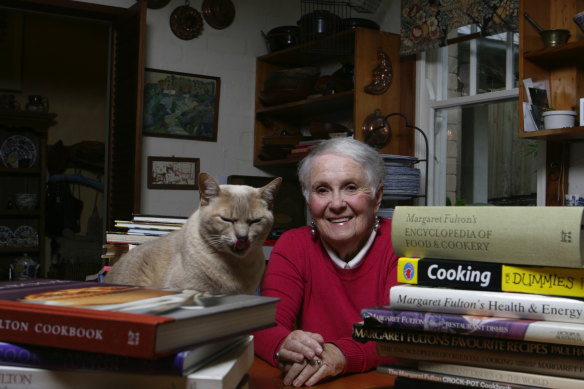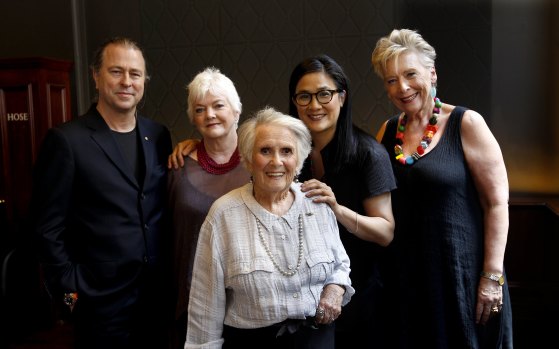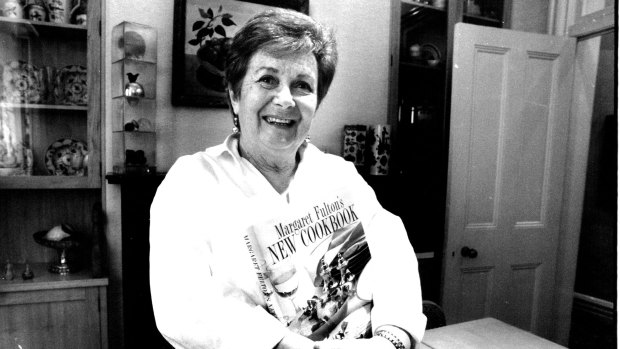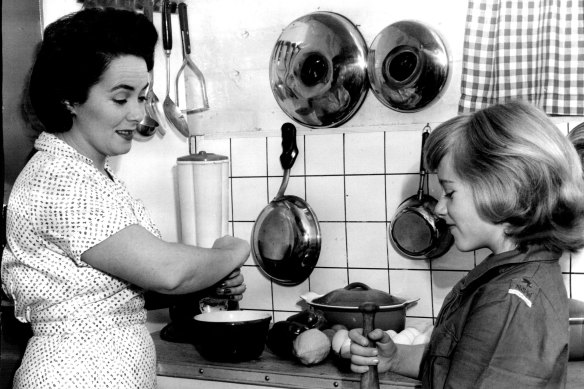By Lynne Cairncross
Margaret Fulton was one of Australia's most influential cookery writers. With her lively manner and curvaceous figure she was Australia's first domestic goddess, albeit a pocket sized version. With her first book, the 1968 best seller, The Margaret Fulton Cookbook, she became a household name and her books lived in almost every kitchen in the country.
Many years after that first book, she appeared on screens again, in a series of television interviews showing she was still as forthright and flirtatious as ever. Her appearance as a judge on the reality television show MasterChef brought her to the notice of a new generation.

Margaret Fulton was one of Australia's most influential cookery writers.Credit: Sahlan Hayes
Fulton's strength was to seize the moment, and the publication of her first book was timely. Post World War II immigration had brought in new people, new food and new ways of cooking, but it was Fulton who was able to persuade everyday housewives to join her on what she termed "a mad cooking adventure". Her own journey, from daughter of Scottish immigrants to cooking celebrity, was not a smooth one.
Her first marriage, in 1948 to guitar playing soldier Trevor Price, broke up after two years, leaving her a single mother with a baby daughter. A second marriage in 1960 to Denis Doonan was a tempestuous affair. In 1980 she met the great love of her life, film producer Mike McKeag. He died just eight years later.
In the late 90s Fulton nearly lost her beloved Balmain house due to an ill-advised investment, and subsequent ten year court battle. Her response was to get down to work, producing more cooking books, an autobiography, and going on the road doing author talks.
A failed business venture in 2003, and the suicide of her business partner marked the start of health problems for Fulton. At 81 in 2005 she a quadruple heart bypass operation. The surgeon warned her to slow down, take it easy, and give up butter. She refused point blank to give up cooking with butter. However she did take up exercise, a "Kama Sutra kind of bendy yoga" as she explained to ABC television interviewer Andrew Denton.
Margaret Isobel Fulton was born on October 10, 1924 in Nairn, Scotland. She was three years old, the youngest of the six children of Alexander and Isabella Fulton, when her family moved from the bustling city of Glasgow, Scotland, to the tiny town of Glen Innes, NSW.

Cooking legends Neil Perry, Stephanie Alexander, Margaret Fulton, Kylie Kwong, and Maggie Beer who will appear on stamps, 2013. Credit: Photo: Steven Siewert
Alexander, a master-tailor, saw Australia as the land of opportunity, so in 1927 they came here to live in a small wooden house with no laundry, just a copper out the back. It was a bit of a culture shock. The next house was still a modest affair, but it was a lively home with conversation encouraged around the dinner table and plenty of entertaining with members of the Caledonian Society and the local Labor Party.
Margaret enjoyed country life, joining the Brownies and the Guides. She was encouraged to air her views on any of the topics being discussed in the home.
In her 1999 autobiography, I Sang For My Supper, Memories of a Food Writer, Fulton said that her real training in food began under the watchful eye of her mother. She recalled being sent to buy some tomatoes. One was not right and she was sent back with it. If the steak she collected from the butcher was not cut right, too thin at one end, she was sent back and told to watch what you are buying. It was her mother, she believed, who taught her that you must use the best ingredients, no matter how humble.

Margaret Fulton with her cook book in 1993.Credit: Brendan Esposito
Fulton might have become a piano teacher, but a violent school hockey match left her with a pulverised thumb. Her parents were relieved and elated when Fulton won a scholarship to study nutrition at the University of Sydney. So in 1943 the tiny, five foot nothing, country girl set off for the city. Not to go to university, no, Fulton had a suitcase full of new clothes she had made. She was going to be a dress designer.
This was wartime Sydney, clothes rationing was in force and women between eighteen and thirty were being called up to work in essential industries. Fulton began her adult life x-raying aircraft parts at a munitions factory in Lidcombe.
A chance meeting with Olwen Francis, the cookery editor of the Australian Women's Weekly changed her life. Francis told her that after the war food, energy and cosmetics would be big growth areas. Fulton chose food and joined the Australian Gas Light Company, baking scones and sponges four times a day showing customers how to make them light and perfect.

Margaret Fulton showing her daughter Suzanne some culinary skills in 1961.Credit: SMH
First she had to quit her wartime job, and the only way to be granted leave was by pretending to be pregnant.
One of her duties with the AGL was to give a cooking class for the blind. Fulton believed it was there, trying to describe her cooking, that set the groundwork for learning how to write recipes that were clear and easy to follow.
Her next job was at the Overseas Corporation, a manufacturing business given the task of turning the mountain of donated aluminium pots and pans not used for the war, into pressure cookers.
After the break-up of her first marriage Fulton moved with her baby Suzanne to the small fishing village of Mooney Mooney on the Hawkesbury, where her sister Jean lived with writer husband Bill Hatfield and their two children.
The Hatfield's had lived in Italy and France and back home kept goats and poultry and grew all manner of Mediterranean vegetables, a delight for Fulton. She found part-time work as a home economist at David Jones and to save her pennies hitched a ride into the city a couple of times a week. One time she had much admired the sleek black limousine that was providing the free ride. The stately car, she discovered, was a hearse, complete with a coffin and corpse in the back.
Fulton became serious about cooking and learned Hotel and Restaurant Cookery at East Sydney Technical College.
She worked for a time with advertising firm J Walter Thompson as an account executive devising a very successful campaign to use the nation's oversupply of sugar. In 1960 she became the food writer for Woman's Day, and the name that sold copies. Through the magazine she travelled extensively, exploring other cuisines, and producing recipes relevant for home cooks.
She also catered. She pulled off a brilliant dinner for the Commonwealth Heads of Government at Berida Manor, a health resort she had established in Bowral. It was the day after the members had been bombed at The Hilton, and security was intense, but the meal went on.
Long past the age of retirement Fulton was busy writing books and fulfilling speaking engagements at everything from international food affairs, to Senior Citizens rallies, and in support of Greenpeace and its battle against genetically modified food. She loved dingoes and for a while was the Vice President of the Australian Native Dog Conservation Society.
Fulton was awarded the Medal of the Order of Australia in 1983, and in 1998 her name was added to the National Trust's 100 Australian Living Treasures.
Margaret Fulton is survived by her daughter Suzanne and granddaughters Kate and Louise.
Lynne Cairncross
Margaret Fulton: 1924-2019.